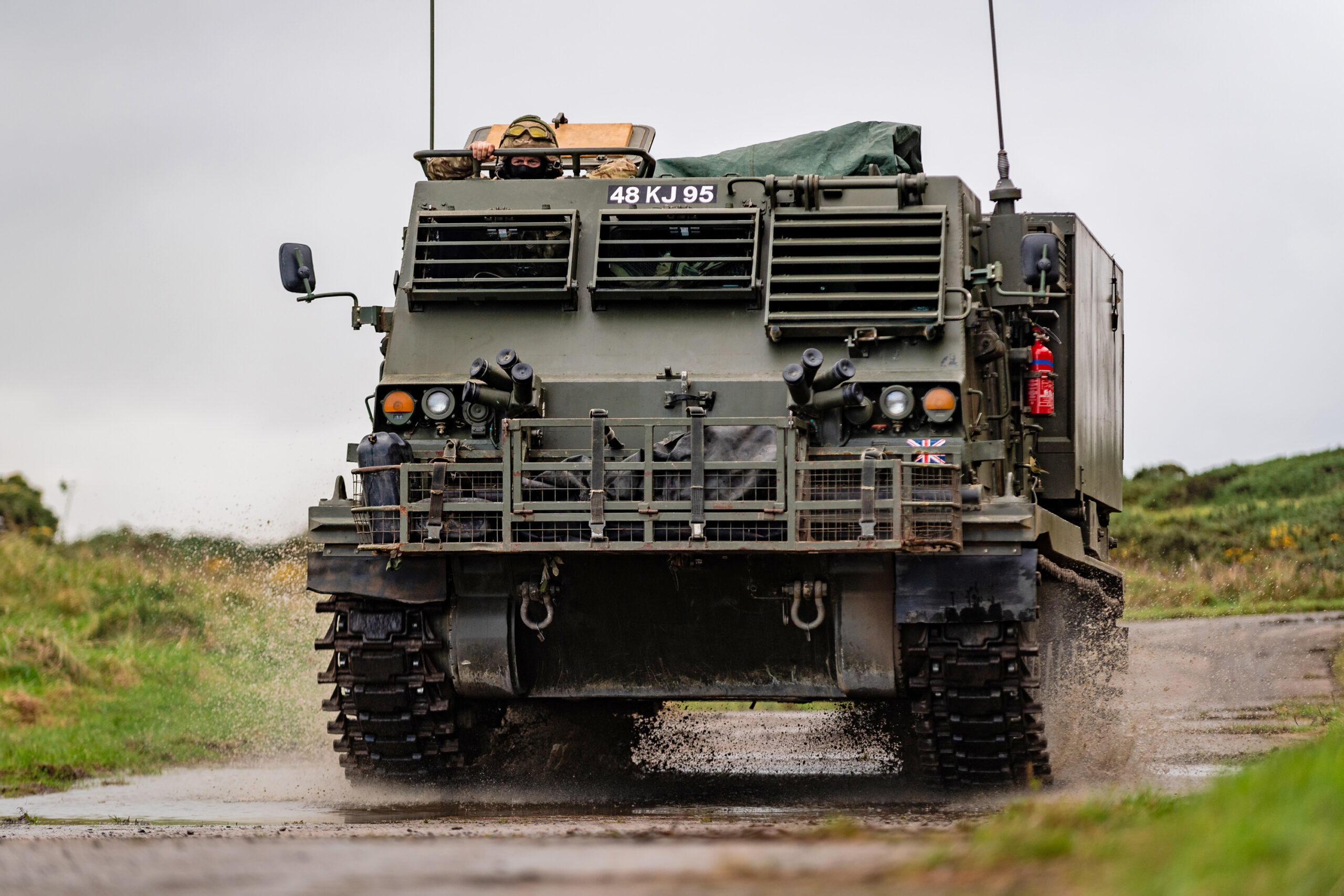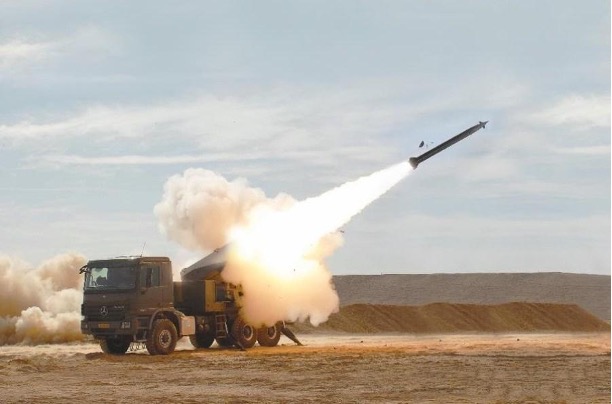It’s been over a year since the release of ‘Rise of the Rocket Launcher: End of the Armored Division’. The premise of the argument was that the future of conventional warfare would be rocket centred and rely heavily on the use of rocket artillery to deliver decisive blows in the deep battle. Russia’s invasion of Ukraine has validated the argument for re-focusing the British Army’s around a core of rocket launchers. This article updates the core arguments presented with observations from Ukraine.
The Armed Forces of Ukraine (AFU) have correctly employed the gifted British M270 and American HIMARS rocket launchers in the deep battle. The shaping of an ‘anti-climactic’ close fight allowed the manoeuvre arms to mount various successful counter-offensives, seen in both the Kharkiv and Kherson oblasts. In these battles, striking Russian air defence and electronic warfare systems with long range rockets allowed for the use of organic uncrewed aerial systems (UAS) to control and accurately deliver close support artillery.
You can never replace the person in the loop…
There are compelling arguments stemming from Ukraine for fewer humans and more technology. Rise of the Rocket Launcher argued that the British Army should forward mount Special Observers during rising tensions into high-risk environments. This would allow them to control fires in depth during the initial stages of any conflict, protect vital ground, and disrupt enemy momentum. If Special Observers had been forward mounted during the Kherson offensive in late 2022, for example, their specialist skills in covert surveillance and targeting expertise would have made AFU artillery and rocket strikes more deadly. During this offensive, Russia (successfully) relied upon the Nova Khakovka and Antonovskiy bridges and as few as five ferry crossing points, to cross the Dnieper River and re-enforce its defensive lines. Employed correctly, Special Observers could have monitored this key terrain and directed rocket artillery to strike assembly areas prior to crossing the Dnieper River. Instead, open-source intelligence (OSINT) showed huge numbers of Russian armour moving unchallenged.

Ukrainian analysts have undoubtably created targetable data based solely on open-source intelligence and exploited the use of social media by Russian soldiers. Civilians throughout Ukraine and partisan networks have also feed into Ukrainian intelligence collect. Dr Matthew Ford discusses the weaponisation of the smart phone, with Ukrainian civilians uploading points of interest to an online system which can be crosschecked with other users or intelligence inputs. Whilst a useful source of information, open source lacks the speed and fidelity a Special Observer provides. Especially if they have an open line of communication to a higher headquarters. This is dependent on civilians having freedom of movement which, as we saw throughout the occupation of Kherson, is likely to be constrained. Social-media and open-source intelligence has a role to play in future targeting, but it should always be one of support to a soldier in the loop.
You can’t shoot what you can’t see!
One incorrect assumption of Rise of the Rocket Launcher is that targeting within conventional warfare would be easy based upon the scale of the conflict. In fact, it is as difficult and labor intensive as during counter-insurgency operations. Both Ukraine and Russia are experiencing an ‘intelligence, surveillance and reconnaissance gap’, struggling to locate targets in isolation. The Ukrainian front stretches almost 1200km, and whilst it is unlikely the British Army will fight a war of this magnitude alone, the scale on which a modern army needs to find targets must still improve. The British war-fighting division currently has very limited lines of intelligence, surveillance, and reconnaissance relying heavily on tactical UAS and very limited numbers of Special Observers. The Deep Reconnaissance Strike Brigade Combat Team is the current ‘find cell’ of the 3rd (UK) Division but must be significantly improved to be credible against the scale of war.

Credit: MOD.
Layered operational and strategic lines of intelligence and surveillance, such as RQ4 Global-Hawk or the use of satellite based synthetic aperture radar (SAR), would enable more successful find and strike. The UK, however, must wait until Project Oberon in 2025 for a UK SAR satellite to enter service and until then we must continue to rely on others. A significant uplift in organic signals intelligence (SIGINT) must also be achieved.
A key element not yet discussed is the targeting process. During the Ukrainian conflict, open-source information has frequently shown images of individual Russian reconnaissance vehicles in ruins following a HIMARS strike. This displays poor weapon to target matching and is an ineffective use of depth fires assets. Instead of prioritising the speed of the ‘kill-chain’, a more integrated intelligence led ‘Fires-Cycle’ would see more effective employment of depth fires assets.1 British Army targeting cells should develop a pattern of life, track enemy vehicles to larger assembly areas and target in a much more deliberate sense. Without an efficient process, a rocket centred division would be fundamentally flawed.
A recent bot writing for the Wavell Room discussed how artificial intelligence (AI) will be a key facet of future warfare. Theoretically, AI could revolutionise the targeting process by analysing and comparing data, and automatically producing mensurated grids usable by depth fires assets. It is not a stretch to suggest that they will be able to identify enemy vehicles, suggest which should be targeted and provide justification as to both when and why. This will be particularly important as the ability to find enemy positions improves and potentially thousands of points of interest require ingestion, prioritisation and action.
Alternative Warheads and Platforms
A focus point of Rise of the Rocket Launcher was the modern family of munitions for the HIMARS family. Whilst briefly mentioned, the alternative warhead (AW) was not given its dues. Capable of firing 84km and covering an area of up to 400m squared with 160,000 tungsten fragments, the AW accounts for any micro displacements in enemy locations and inaccuracies in the targeting. This helps quicken the targeting process and ultimately leads to more enemy casualties. One AW missile can achieve the same effect as firing a large open sheath of GMLRS-Unitary missiles, without driving up the cost of war and further burdening the logistics chains. The British Army must remain at the forefront of technological advances and missile development to truly be able to strike high value depth targets as precisely as possible. It must also, as recently warned by Tobias Ellwood MP, upgrade its stockpiles of ammunition to meet NATO commitments.

Conventional warfare is won and lost in the deep. But the close battle must still be resourced efficiently and artillery will be required to provide mass as well as precision. The British Army’s Future Soldier paper promises to ‘double the proportion of deployable force that contributes to deep effects’ and a ‘major investment in world class equipment’. The British Army’s M270 GMLRS is proving extremely effective in the Russian-Ukrainian conflict, and many US allies bordering Russia are scrambling to purchase the HIMARS. Despite this, the British Army should not be distracted by HIMARs and should look at a different platform. Finances and logistics are key drivers during kit procurement, and these restrictions can be satisfied through the purchase of the Elbit Systems Precise and Universal Launching System (PULS). The PULS provides flexibility to support both the close and deep battles. The multipurpose launcher is positioned on a cheap frame giving a significant reduction in purchase, maintenance, and training costs. PULS can interchange its two rocket pods to provide 36 rockets at 35km, 20 rockets at 40km, 8 rockets at 150km or 4 rockets at 300km, satisfying the requirements of both mass and precision.
Conclusion
I stand by the original argument for a British rocket division, although there are lessons to be learned from the recent, rocket centred conflict in the Ukraine.
Finding the enemy is currently the biggest hurdle. The early deployment of Special Observers, along with investment in operational level intelligence and surveillance capability must accompany a credible rocket division. In order to strike highly mobile targets in both the close and deep battles, quickly and on mass, the British Army should look to adopt a new universal fires platform such as the Elbit Systems PULS and equip it with an AW style missile capable of firing with less accurate location reporting. This cheaper option would allow for a huge increase in available platforms.
Finally, a rocket division must be underpinned by intelligence led doctrine to maximise effect in the deep battle. It should be open to AI based autonomous processes and the weaponisation of social media in support of targeting. If these conditions are met, the British Army would have a more flexible and credible fighting division, ready for modern conventional conflict. With depth fires assets quickly becoming the currency of power for militaries across the world, the time for change is now.
Cover photo: A Guided Multiple Launch Rocket System (GMLRS) moving to a firing position at Kirkcudbright Ranges. Credit: MOD.

Simon Middleton
Captain Simon Middleton is a Fire Support Team (FST) Commander and Troop Commander at 5thRegiment Royal Artillery – The Army’s Surveillance, Target and Acquisition Regiment. Commissioned in December 2017, he initially posted to 1stRegiment Royal Horse Artillery before his Battery re-subordinated to 26thRegiment Royal Artillery. There he served two tours as a Troop Commander with operational roles of both Battery Reconnaissance Officer and Command Post Officer. He deployed on exercises in the USA, France, Norway, Austria and Germany prior to his FST Commanders course and unit move.
The views expressed in his writing are his and do not represent the views of the Ministry of Defence.


